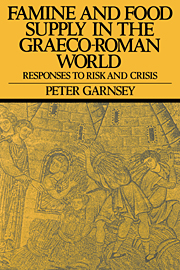Book contents
- Frontmatter
- Contents
- List of tables and figures
- Preface
- Abbreviations
- Maps
- PART I THE INCIDENCE AND SEVERITY OF FOOD CRISIS
- PART II SURVIVAL STRATEGIES
- PART III FOOD SUPPLY AND FOOD CRISIS IN ATHENS C. 600–322 BC
- 6 The resources of Attica
- 7 The beginnings of dependence
- 8 Rulers of the sea
- 9 Vulnerability and vigilance
- 10 From uncertainty to crisis
- PART IV FOOD SUPPLY AND FOOD CRISIS IN ROME C. 509 BC – AD 250
- CONCLUSION
- Bibliography
- Index
9 - Vulnerability and vigilance
Published online by Cambridge University Press: 12 November 2009
- Frontmatter
- Contents
- List of tables and figures
- Preface
- Abbreviations
- Maps
- PART I THE INCIDENCE AND SEVERITY OF FOOD CRISIS
- PART II SURVIVAL STRATEGIES
- PART III FOOD SUPPLY AND FOOD CRISIS IN ATHENS C. 600–322 BC
- 6 The resources of Attica
- 7 The beginnings of dependence
- 8 Rulers of the sea
- 9 Vulnerability and vigilance
- 10 From uncertainty to crisis
- PART IV FOOD SUPPLY AND FOOD CRISIS IN ROME C. 509 BC – AD 250
- CONCLUSION
- Bibliography
- Index
Summary
Democracy was unexpectedly restored in Athens in 403/2 by the Spartans and more predictably abolished by the Macedonians 81 years later. After a period of subservience to Sparta, Athens staged a revival dating from the battle of Cnidos in 394, which was followed up by the recovery of the islands of Lemnos, Imbros and Skyros in 392, and the capture of Byzantium and imposition of a 10% toll on all transit goods in 390. The revival had run its course by 388/7 (though the three islands remained Athenian possessions). The Spartans had retained their footholds in the Hellespont at Abydos and Sestos. Now they reasserted their authority by closing the Hellespont (while ‘pirates’ raided the Piraeus) and imposing peace on the Greek world with the aid of the Persian King (387/6). A second and more lasting Athenian resurgence was soon in progress. Profiting from the unpopularity of Sparta, the Athenians were already by the late 380s beginning to strike alliances with important states (Chios was an ally by 384), and in the summer of 378 formed the Second Athenian League. By 373 there were about 60 member states. Athens was arguably once again the strongest naval power.
The League had ceased to function as an instrument of power-politics by the mid-350s, when Athens was defeated by her allies in the Social War (357–355 BC). However 338, the date of the Macedonian victory at Chaeronea, was an even more crucial turning-point in the history of Athens. Before Chaeronea the Athenians were competing with other mainland states and latterly the emerging power of Macedon for influence and prestige in the Greek world.
- Type
- Chapter
- Information
- Famine and Food Supply in the Graeco-Roman WorldResponses to Risk and Crisis, pp. 134 - 149Publisher: Cambridge University PressPrint publication year: 1988



